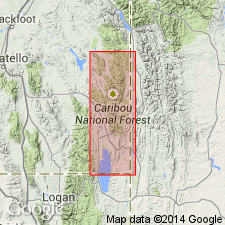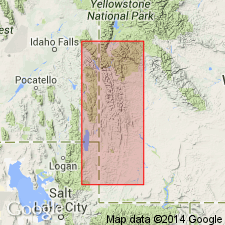
- Usage in publication:
-
- Peterson limestone*
- Modifications:
-
- Named
- Dominant lithology:
-
- Limestone
- AAPG geologic province:
-
- Wasatch uplift
Summary:
Named as a formation in the Gannett group for Peterson's ranch along Tygee Creek in sec 34, T7S, R46E, Caribou Co, ID on the Wasatch uplift. No type locality designated. Is a 200 ft thick, massive-bedded near top, persistent ridge-forming, fossiliferous limestone. Contains freshwater fossils. Overlies Ephraim conglomerate (new) of Gannett group (new); underlies Bechler conglomerate (new) of Gannett. Assigned to the Cretaceous?.
Source: GNU records (USGS DDS-6; Denver GNULEX).

- Usage in publication:
-
- Peterson Limestone
- Modifications:
-
- Overview
- Areal extent
- AAPG geologic province:
-
- Snake River basin
- Wasatch uplift
- Green River basin
- Yellowstone province
Summary:
Is one of five formations in the Gannett Group. Overlies Ephraim Conglomerate of Gannett; underlies Bechler Formation of Gannett. Isopach map; ranges from less than 5 to 250+ ft thick; present in Lincoln Co, WY (Greater Green River basin), Teton Co, WY (Yellowstone province), Caribou Co, ID (Wasatch uplift), and Bonneville, Madison, Teton, and Bingham Cos, ID (Snake River basin). Is thickest in western Lincoln Co, WY and adjacent eastern Caribou Co, ID. Type section stated to be on the Peterson ranch where the formation is only 200 ft thick; probably 40-50 ft of formation is covered at the type. Consists of limestone and interbedded gray and red calcareous shale. The limestone is considered to be an algal limestone made up of 50+ percent calcified charophytes, vegetative material, gyrogonites, and ostracods. Most of the limestone is sublithographic and lithologically indistinguishable from the Draney Limestone of the Gannett. The limestone is of freshwater lacustrine origin. Abundant microfossils in most of the shales. Cross sections. Of Aptian, Early Cretaceous age. Section in Lincoln Co measured.
Source: GNU records (USGS DDS-6; Denver GNULEX).
For more information, please contact Nancy Stamm, Geologic Names Committee Secretary.
Asterisk (*) indicates published by U.S. Geological Survey authors.
"No current usage" (†) implies that a name has been abandoned or has fallen into disuse. Former usage and, if known, replacement name given in parentheses ( ).
Slash (/) indicates name conflicts with nomenclatural guidelines (CSN, 1933; ACSN, 1961, 1970; NACSN, 1983, 2005, 2021). May be explained within brackets ([ ]).

